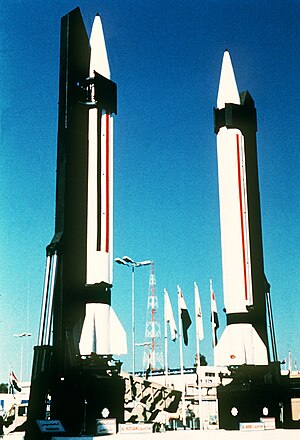Al Hussein (missile)
| Al-Hussein | |
|---|---|

Al-Hussein missiles displayed in their erector-launchers.
Baghdad arms exhibition, April–May 1989. |
|
| Type | Single-stage ballistic missile |
| Service history | |
| In service | 1987-1991 |
| Production history | |
| Manufacturer | Iraq (1987–91) |
| Specifications | |
| Weight | 14,110 lb (6,400 kg) |
| Length | 41.5 ft (12.46 m) |
| Diameter | 3 ft (0.9 m) |
| Warhead | 1,102 lb (500 kg) of payload High explosive Chemical, Biological and Nuclear capabilities |
|
|
|
| Engine | Liquid propellant |
|
Operational
range |
400 miles (≈644 km) |
| Flight altitude | 94 miles (≈151 km) |
| Speed | 0.9 miles/s (1.5 km/s) |
|
Guidance
system |
Inertial |
|
Launch
platform |
3 Mobile launchers: MAZ-Soviet modified Al-Whaleed-local production Al-Nida-local production Concrete silo |
Al Hussein or al-Husayn (Arabic: الحسين) is the designation of an Iraqi ballistic missile. The missile was the result of upgrading the Soviet made Scud in order to achieve a longer range. The weapon was widely used by the Iraqi Army during the Iran–Iraq War and the Gulf War of 1991.
The origins of the Al-Hussein could be traced back to the first stages of the war with Iran. Iraq was the first belligerent to use long range artillery rockets during the Iran–Iraq War, firing limited numbers of FROG-7s at the towns of Dezful and Ahvaz. Iran responded with Scud-Bs obtained from Libya. These missiles can hit a target 185 miles away, therefore key Iraqi cities like Sulaymaniya, Kirkuk, and Baghdad itself came within the range of this weapon.
Iraq, which also deployed the Scud-B, was conversely unable to strike the main Iranian industrial centers, including the capital, Teheran, because these are located more than 300 miles from the border. To surmount the Iranian advantage, Iraqi engineers designed a program to upgrade the original Scuds into a series of ballistic missiles whose range would surpass 500 miles. The assembly facility was located near Taji.
The first development, called Al-Hussein or Project 1728, with a range of 400 miles, allowed the Iraqi army to attack deep inside the Iranian boundaries. The range was extended by reducing the original 945 kg warhead to 500 kg and increasing the propellant capacity. The warhead carried HE, although it had chemical, biological and nuclear capabilities. According to UN inspectors reports, the Iraqis were able to produce all the major components of the system by 1991. The Al-Hussein was 12.46 meters long and had a diameter of 0.88. The guidance was inertial, without terminal phase. The altitude where the motor burnt out was 31 miles, while the trajectory highest altitude or apogee, was 94 miles. The accuracy for the impact, or Circular error probable, was estimated in a radius of 1,000 meters, and the missile launch weight was 6,400 kg. Its flight time was of about seven minutes for the maximum range.
...
Wikipedia
